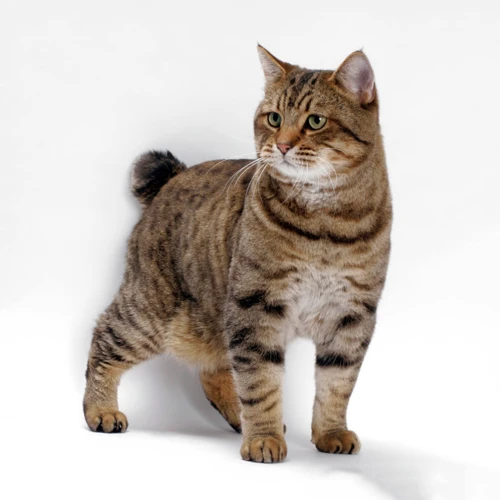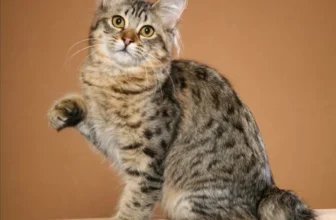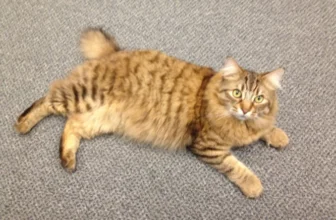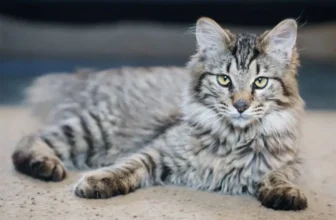The world of cat breeding is constantly evolving, and one breed that has caught the attention of many is the American Bobtail. With its unique physical traits and playful personality, it has become a popular choice among cat lovers. However, as with any other breed, there is always the possibility of crossbreeding. Many wonder what the impact of crossbreeding American Bobtail with other breeds could have on its evolution. In this article, we will delve into the subject to understand the history and physical traits of the American Bobtail, as well as explore the concept of crossbreeding and its impact on this particular breed’s evolution. Are you curious about the future of the American Bobtail? Keep reading to find out.
Understanding American Bobtail

The American Bobtail is an enchanting breed with unique characteristics that has become increasingly popular in recent years. To truly understand the impact of crossbreeding on the evolution of the American Bobtail breed, it is imperative that we first delve into the origins and physical traits of this fascinating feline. The American Bobtail breed has a rich history that can be traced back many years – to learn more about its roots, check out the origins of the American Bobtail breed. Additionally, understanding the distinctive physical characteristics of American Bobtail is important when examining how it has evolved – for more on this, head over to our article on American Bobtail characteristics and the evolution of the American Bobtail Breed Standard.
The Origin of American Bobtail
The American Bobtail is a unique cat breed with a fascinating history. Its origins can be traced back to the 1960s in the United States, where it was first discovered in Arizona. The breed is the result of natural selection and adaptation to the rugged terrain of the American wilderness.
Here are some interesting facts about the origin of the American Bobtail:
- It is believed that the American Bobtail is a result of the breeding between a domestic cat and a wild bobcat
- The breed was developed through natural selection, with the cats best adapted to the environment surviving and passing on their genes to future generations
- The American Bobtail’s distinctive tail is a result of genetic mutation
- The first American Bobtail to be registered was named Yodie, in the early 1970s
The American Bobtail is often compared to the Manx cat, as both breeds have a naturally occurring genetic mutation that results in a shortened tail. However, the American Bobtail has a longer and more robust tail than the Manx.
The environment and climate also played a significant role in shaping the American Bobtail. The breed developed thick coats to protect it from the harsh winter conditions and sharp claws to help them climb and hunt for prey.
For more information on the evolution of cat breeds like the American Bobtail, you can check out our article on the ‘Manx-American Bobtail Evolution’.
Physical Traits of American Bobtail
The American Bobtail is a unique breed of cat that possesses several physical traits that set it apart from other cat breeds.
Body: The American Bobtail has a distinctive body shape that is sturdy and athletic. They often have a broad chest and short, muscular legs. They are considered medium to large in size and can weigh anywhere from 7 to 16 pounds.
Coat: The coat of an American Bobtail can range from short to medium in length and is thick and soft. It can come in a variety of colors and patterns, including tabby, tortoiseshell, and solid colors like black, white, and grey.
Tail: The most noticeable physical characteristic of the American Bobtail is their tail. They have a short, bobbed tail that can range from 1 to 4 inches in length. The tail is usually straight or slightly curved and can be either straight or slightly kinked.
Head: The head of an American Bobtail is broad and wedge-shaped with high cheekbones and a prominent brow. They have large, expressive eyes that are usually almond-shaped and can range in color from green to gold.
Ears: The ears of the American Bobtail are medium to large in size and are often tufted, giving them an exotic appearance.
The physical traits of the American Bobtail make them a striking and unique breed of cat. Their short, bobbed tail is particularly notable and sets them apart from other breeds.
The evolution of American Bobtail and Manx breeds has resulted in the development of similar traits, such as the short tail, in cats that were bred for the same purposes. Additionally, the environment and climate in which the breed developed likely played a role in shaping their physical characteristics.
What is Crossbreeding?

As we delve deeper into the world of American Bobtail and its evolution, one term that keeps popping up is crossbreeding. Most of us know it as the practice of mating two different breeds to create a new mix, but what exactly does that mean for the American Bobtail breed? How does it affect their gene pool and evolution? Let’s break it down and explore the intricacies of crossbreeding, and its role in shaping the American Bobtail we know today.
Why Crossbreed?
Crossbreeding is not a new concept in the animal world. The practice of crossbreeding can have several reasons, ranging from achieving specific traits to addressing health concerns. In the case of American Bobtail, crossbreeding can help improve the breed in many ways.
Here are some of the common reasons why breeders crossbreed American Bobtail:
| Reasons for Crossbreeding | Explanation |
|---|---|
| Breeding for specific traits | When a particular trait is desired in a breed, breeders may choose to crossbreed it with another breed that has that trait. For instance, if a breeder wants to create a bobtail with a specific coat color or pattern, they will crossbreed with a breed that has that color or pattern. |
| Improved health | Crossbreeding can reduce the risk of genetic disorders that afflict purebred cats. By introducing new genes into the population, breeders can reduce the likelihood of inherited health problems. |
| Introducing new genes | When a breed has a small gene pool, crossbreeding can help introduce new genes into the population, which can make the breed healthier, more resilient, and more genetically diverse. |
| Creating a new breed | Crossbreeding two different breeds can result in the creation of a new breed. For instance, when American Bobtail is crossbred with another breed, the progeny may end up having unique physical and temperament characteristics, which may be recognized as a new breed. |
While crossbreeding can have several benefits, it is important to understand the implications of introducing new genes into a breed’s gene pool. In the case of American Bobtail, breeders need to be mindful of the potential drawbacks that come with crossbreeding. The next section explores the pros and cons of crossbreeding American Bobtail.
The Impact of Crossbreeding in American Bobtail Evolution
Crossbreeding American Bobtail with other breeds has become a common practice among cat breeders. While crossbreeding can lead to the development of new and unique breeds, it also has its drawbacks. In this section, we explore the impact of crossbreeding on American Bobtail evolution and delve into the pros and cons of crossbreeding this breed. We will also examine how crossbreeding affects the gene pool of American Bobtail and discuss the future of this breed in relation to crossbreeding. So, let’s take a closer look at the impact of crossbreeding on American Bobtail evolution.
The Pros and Cons of Crossbreeding American Bobtail
Crossbreeding a breed like American Bobtail comes with its own set of advantages and disadvantages. Let’s take a look at some of the pros and cons of crossbreeding American Bobtail.
Pros:
- Improved health: Crossbreeding American Bobtail with other breeds can help reduce the risks of genetic health problems.
- Unique traits: Crossbreeding American Bobtail with other breeds can lead to the development of unique physical and behavioral traits, which can further enhance the breed’s desirability.
- Diversity in gene pool: Crossbreeding expands the gene pool of American Bobtail, which can help prevent inbreeding and genetic abnormalities.
- Increased popularity: Crossbreeding can help increase the popularity of American Bobtail by creating new, unique breeds that catch the attention of cat lovers.
Cons:
- Lack of predictability: Crossbred American Bobtails may not always exhibit the desired traits, making it difficult to predict their physical and behavioral characteristics.
- Reduced purity: Crossbreeding can result in a reduction of the purity of the breed, which may not be desirable for those who are specifically seeking purebred American Bobtail.
- Risk of health issues: Crossbreeding can also increase the risk of health issues, such as hereditary diseases, which may become more common due to the genetic mixing.
- Unforeseen behavioral issues: Crossbreeding may lead to unexpected behavioral issues that may not be present in either parent breed.
As you can see, there are both pros and cons to crossbreeding American Bobtail. It’s up to breeders and cat lovers to weigh the pros and cons and decide whether they want to engage in crossbreeding. Despite the potential cons, crossbreeding has led to some of the most beloved and unique cat breeds in existence today.
Famous Crossbred Bobtail Breeds
The American Bobtail is a unique breed that has been adapted into numerous crossbred breeds by breeders for various reasons since the beginning of the 21st century. Some of the most famous crossbreeds of the American Bobtail include the following:
- Pixie-bob: one of the most well-known crossbreeds of the American Bobtail. This breed was created by mating a domestic cat with a wild American bobcat, which gives the Pixie-bob its distinctive wild appearance.
- Bengal Bobtail: This breed is the result of crossing the American Bobtail with the Bengal cat. This cross resulted in a medium-sized cat with a muscular body, extremely soft fur, and affectionate disposition.
- Savannah Bobtail: This is another crossbreed that is a result of mating the American Bobtail with the Savannah cat breed. The Savannah Bobtail is an energetic cat with a playful disposition and a strong hunting instinct.
- Highlander: This breed is the result of mating the American Bobtail with the Desert Lynx and the Jungle Curl. The Highlander breed has a distinctive wild appearance, a curled tail, and ear tufts similar to those of the lynx.
These crossbred American Bobtail breeds are becoming increasingly popular among cat lovers worldwide. They inherit their unique characteristics from their American Bobtail lineage, while their breeding with other breeds results in an even more diverse gene pool. These breeds not only look amazing but also offer a wide range of personality traits that make them perfect for different kinds of homes. Breeding has undoubtedly enriched the characteristics of the American Bobtail and given the breed a much more diverse gene pool from which to draw.
How Crossbreeding Affects the Gene Pool of American Bobtail
When American Bobtail cats are crossbred with other breeds, it inevitably affects their gene pool. Here are some specific ways that crossbreeding impacts the gene pool of American Bobtail:
- Genetic Diversity: Crossbreeding can increase the genetic diversity within the American Bobtail gene pool. This means that there are more variations in the genes that are present, which can be beneficial for the overall health of the breed.
- New Traits: When two breeds are crossed, it is possible for new traits to emerge in the offspring. Some of these traits may be desirable (such as a unique coat pattern or eye color), while others may not be desirable. Over time, these new traits can become more common within the American Bobtail gene pool.
- Risk of Health Issues: Whenever two breeds are crossed, there is a risk of introducing health issues into the gene pool. For example, if one of the parent breeds is known for a particular health problem (such as hip dysplasia), then there is a risk that this problem may become more prevalent within the offspring. This is why it is important for breeders to carefully select the parent breeds and ensure that they are both healthy.
It is worth noting that crossbreeding can have both positive and negative effects on the gene pool of American Bobtail cats. While it can increase genetic diversity and potentially introduce new and desirable traits, it can also introduce health risks. It is important for breeders to carefully consider the potential impact of crossbreeding on the American Bobtail gene pool and to make informed decisions about which breeds to cross with American Bobtail cats.
The Future of American Bobtail: Will Crossbreeding Continue?
The future of American Bobtail is a topic that keeps many people interested. We have seen how crossbreeding has impacted the evolution of American Bobtail, but what does the future hold? Will crossbreeding continue to play a significant role, or will breeders focus more on purebred American Bobtails?
The Pros and Cons of Continuing Crossbreeding
There are both pros and cons to continuing crossbreeding American Bobtail. On one hand, crossbreeding can lead to new and unique breeds that possess qualities from both parents. This can be a positive thing, especially if the breeds used in the crossbreeding are known for their health and personality traits. Crossbred American Bobtail breeds, such as the Pixie-Bob or the Himalayan Bobtail, have already proven to be popular and successful.
However, there are also potential negative consequences to continuing crossbreeding. One of the biggest risks is that breeders may prioritize physical appearance over health or temperament, leading to the creation of unhealthy or aggressive cats. Additionally, crossbreeding can further dilute the already limited gene pool of American Bobtail, potentially leading to health issues down the line.
Famous Crossbred Bobtail Breeds
There are a number of crossbred American Bobtail breeds that have become famous and popular. Some of the most well-known include:
| Breed | Parent Breeds | Description |
|---|---|---|
| Pixie-Bob | American Bobtail Domestic Shorthair |
A muscular and wild-looking breed that is known for its friendly and loyal personality. |
| Himalayan Bobtail | American Bobtail Himalayan |
A long-haired breed that is known for its striking appearance and friendly disposition. |
| Siamese Bobtail | American Bobtail Siamese |
A playful and active breed that is known for its intelligence and talkative nature. |
The Future of American Bobtail
It is difficult to predict the future of American Bobtail with certainty. It is likely that crossbreeding will continue to play a role in the evolution and development of the breed, but breeders will need to be mindful of the potential risks and consequences. As long as health and temperament remain a priority, crossbreeding can be a positive thing for the breed. However, if breeders prioritize physical appearance over everything else, the breed could suffer. Ultimately, the future of American Bobtail will depend on responsible breeding and a commitment to preserving the health and unique qualities of the breed.
Conclusion
After exploring the crossbreeding of American Bobtail with other breeds, it is clear that this practice has had a significant impact on the evolution of this feline species. While some may argue that crossbreeding dilutes the purity of the breed, others believe that it can enhance the breed’s health, temperament, and physical appearance.
One thing is certain, however: crossbreeding cannot be ignored. It has already led to the development of several popular and unique bobtail breeds, including the Pixie-Bob and the Bengal Bobtail. These cats have all the charm and charisma of the American Bobtail, but with added characteristics that make them even more distinctive and eye-catching.
It is important to note that crossbreeding should only be done with care and attention to genetic health. This practice should not be taken lightly, as it can have negative consequences if not done correctly. Breeders should always aim to improve the overall health and well-being of their cats, rather than simply creating a new and trendy breed.
As for the future of American Bobtail, only time will tell if crossbreeding will continue. It is likely that this practice will continue to be a topic of debate among breeders and enthusiasts alike. However, with careful consideration and planning, crossbreeding has the potential to enhance the American Bobtail breed while still maintaining its unique characteristics and charm.
In conclusion, the crossbreeding of American Bobtail with other breeds has had a significant impact on the evolution of this feline species. While it may not be without its controversies, responsible and careful crossbreeding can lead to the development of new and unique breeds that retain the charm and charisma of the American Bobtail while adding additional desirable traits. Breeders and enthusiasts alike should approach crossbreeding with care and attention to genetic health, always striving to improve the overall well-being of these beloved animals.
Frequently Asked Questions
1. Can the American Bobtail be crossbred with any breed?
No, crossbreeding should be done with caution and should only be done with breeds that complement the American Bobtail’s genetic makeup.
2. What are the benefits of crossbreeding American Bobtail?
Crossbreeding can result in a healthier cat, as it can reduce the likelihood of genetic diseases and increase genetic diversity.
3. Can crossbreeding negatively impact the temperament of American Bobtail?
Yes, crossbreeding can potentially produce offspring with unpredictable temperaments. It’s important to only crossbreed with compatible breeds that have similar temperaments.
4. Are there any famous American Bobtail crossbreeds?
Yes, some of the famous crossbreeds include the American Curl Bobtail, the Pixie-Bob, and the Bengal Bobtail.
5. How does crossbreeding impact the physical appearance of American Bobtail?
Crossbreeding can introduce new physical traits or alter existing ones, which can result in variations in size, fur type, and color.
6. Can crossbreeding affect the lifespan of American Bobtail?
While crossbreeding can potentially reduce the likelihood of genetic diseases, it’s important to consider the health and lifespan of both breeds before breeding them together.
7. Can American Bobtails be crossbred with wild cats?
No, it’s illegal and highly discouraged to breed domestic cats with wild cats, as it can result in hybrid offspring that may be dangerous and difficult to care for.
8. How does crossbreeding impact the price of American Bobtail?
Crossbred American Bobtails may be more expensive than purebred ones, depending on the rarity and popularity of the breed combination.
9. Can crossbreeding help preserve endangered cat breeds?
Yes, crossbreeding can introduce genetic diversity and help prevent inbreeding, which can ultimately help preserve endangered breeds.
10. What should I consider before crossbreeding my American Bobtail?
You should research the breed you want to crossbreed with thoroughly, consider the potential temperament, health, and physical traits of the offspring, and consult with a veterinarian or professional breeder before proceeding.







